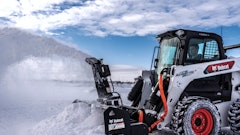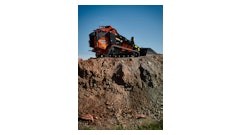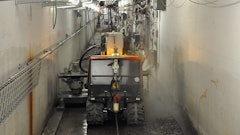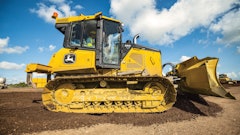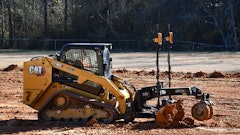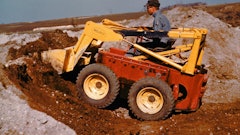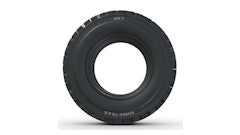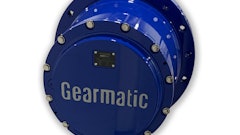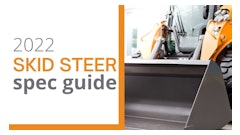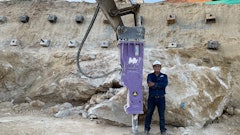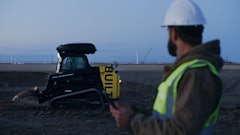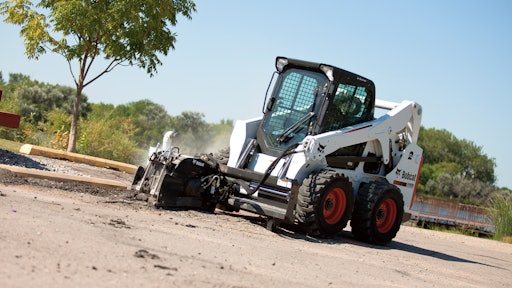
Skid steers and compact track loaders (CTLs) feature high-performance hydraulic systems capable of running an ever-growing number of hydraulic-powered attachments. In addition, hydraulic systems drive the machines, lubricate against wear and corrosion and cool many of the components.
Hydraulic system performance has gradually increased over the years through tighter tolerances. But this also makes them less tolerant of contamination. It is the No. 1 reason these systems fail.
“Key sources of contamination can be particle contamination such as dirt or metal or contamination such as water or air,” says Keith Kramlich, national service & warranty manager, Takeuchi US.
Dirt and metal are the most common culprits. Trace amounts of metal particles in the hydraulic system are considered normal, especially on a new machine during its break-in period. Dirt is another issue. “Dirt enters the system through attachment changes and poor maintenance practices,” says Kramlich.
1. Pay Attention to Quick Couplers
Quick couplers allow the attachment versatility that makes skid steers and CTLs so popular. As such, they require careful attention.
“Dust, dirt, mud, etc. can be transferred into the system during the coupling of the auxiliary lines,” notes Jeff Jacobsmeyer, Kubota construction equipment product manager. “Contamination can be prevented by carefully wiping the coupler surfaces before hookup. Operators need to be sure the hoses are up out of the dirt and away from any source of moisture.”
Extra precautions can limit contaminants entering through quick couplers. “When storing an attachment, clean the quick connects and seal them off from the environment using a plastic bag or cover,” advises Kramlich. When the attachments are not connected, make sure the caps are in place and replace any caps that do not fit tightly.
Drain any pressure built up in the hydraulic lines of the attachment after use. While relieving the pressure will not directly lower contaminant exposure, it will reduce the possibility that the operator will need to loosen the hydraulic fitting, which can lead to a greater risk of contamination.
2. Keep Oil Clean
Oil is the lifeblood of the loader, and it is shared with the attachments. Beware of the risk when connecting an unfamiliar hydraulic attachment to your equipment. You don’t know the condition of the oil stored in it. Also make sure you are topping off the loader with the correct fluid. There is a risk of fluid incompatibility.
Some OEMs caution against mixing brands and types of hydraulic fluid. “It is never recommended to mix oils as it will compromise the properties of each oil, which could lead to premature wear,” says Kramlich.
There may be cases where a manufacturer uses different viscosities and oil types. “For example, Takeuchi uses engine oil in its CTL’s hydraulic system for better protection on certain components,” says Kramlich. “You want to ensure the attachments are not utilizing standard hydraulic oil as it will contaminate the machine’s system.”
Bobcat recommends using an oil that is specifically blended for its machines. “That hydraulic oil has an additive which helps water molecules adhere to each other and become a water droplet,” says Mike Fitzgerald, product specialist, Bobcat. “Then those water droplets are caught in the hydrostatic filter.”
The oil has also been formulated to match the temperature, pressure and other operating requirements. “You can use an alternative oil, but you might not see as long of life on components as you would utilizing the Bobcat specific oil,” says Fitzgerald.
Consider viscosity and oil temperature range when selecting a hydraulic fluid. Make sure when you replace the fluid that you are at least using the same type. Most industrial fluids use the ISO viscosity grade scale. The most common hydraulic oil viscosity grades in the ISO category are 32, 46 and 68.
There are differing opinions when it comes to hydraulic fluid and attachment use.
“Any contamination can affect the additive properties of the machine’s hydraulic oil,” Kramlich states. “Use only new attachments or attachments you have already used and know the hydraulic oil is clean and correct.”
Other manufacturers claim the small amount of oil held in typical attachments does not present a very big risk of contamination. “The amount of oil that is held in the attachment is usually a very small percentage of what would be in the complete system in a machine,” says Fitzgerald. “Therefore, it does not have a huge effect. The oils that manufacturers are using today should be compatible.”
“Oil volumes, for the most part, are small in the attachments compared to the overall size of the hydraulic reservoir in most machines,” Jacobsmeyer agrees. “A mixing of the oil is expected and this factor has been addressed during the engineering and oil type selection for the loader.
“Owners should adhere to the recommended service intervals for the hydraulic oil and filter changes to ensure long component life,” he continues. “If the loader is used with several different attachments — maybe from a number of different rental yards — it would be a good practice to change the filter and oil more often than manufacturer recommendations as an extra precaution against unwanted contamination.”
3. Oil Changes Are Not Optional
Hydraulic fluid begins to deteriorate from being heated and cooled during normal operation. Overheated oil forms varnish, causing valves and other components to stick.
“Heat is another form of ‘contamination’ which can be caused by clogged oil coolers, air in the system, poor quality oil, debris around the hydraulic components, etc.,” says Kramlich. “Heat decreases the viscosity of the hydraulic oil, which will increase wear and can lead to catastrophic damage. The viscosity of the oil has to be sufficient enough that the area between any moving parts is completely covered by an oil film. If not, there will be metal to metal contact.”
Daily maintenance is critical to prevent excessive heat in the system. “It is vital to check the oil cooler to ensure that it is clean, as well as check the area around any hydraulic components to ensure they are not covered in debris,” Kramlich emphasizes. “For example, always make sure the belly pans on the CTLs and skid-steer loaders are clean. Excessive debris in the belly pans around the HST pumps prevents heat dissipation from the pump group.”
Oil condition should also be monitored. This includes checking the color and cleanliness of the hydraulic oil. “If it looks dirty or burnt, it needs to be changed,” says Kramlich. “Check all hoses for cracks and signs of wear and replace if needed.”
4. Water and Leaks Shorten Oil Life
“Water and air contamination can damage the hydraulic system, as well,” says Kramlich. “When air enters the system through a cracked suction line, damaged fitting or low oil in the reservoir, it can cause excessive heat, erratic operation and increased wear on components. Water in the system can dilute the hydraulic oil and decrease lubricity and viscosity.”
Water may be introduced to the system when operating in high humidity areas. “When hot oil cools down, moisture may enter the system through the hydraulic tank vent,” Fitzgerald explains. “The oil (along with specific additives) and filtering system need to be able to account for this.”
Monitor for oil leaks and regularly check the hydraulic fluid level. An inadequate amount of oil can cause severe damage to pumps. Foamy or milky hydraulic oil appearance is an indication that you may have a leak that is causing air to enter the system.
“Daily walk-arounds need to include checking for leaks, pinched lines and damaged lines/fittings before and during operation of the attachment,” says Jacobsmeyer. When topping off the hydraulic fluid, clean the refill cap and surrounding area prior to removal.
5. Check Attachments After System Failures
“It is imperative that if contamination has occurred that both [the carrier and attachment] be flushed, filters changed and new oil installed. A shorter interval for the hydraulic filter and oil replacement after the repair may be needed to monitor the condition of the machine in the event of a major failure,” says Jacobsmeyer. “This protocol needs to be followed to the letter if a major component failure occurred and metal shavings entered the system.”
Cross contamination is an issue that can be easily overlooked. “When your oil becomes contaminated in the machine, then you would have that same oil in the attachment,” Fitzgerald points out. “If the oil has deteriorated or you have some reason other than the normal maintenance schedule to change it out, we recommend that you drain the oil out of the attachment and hoses. It is always a good practice to check your attachments and make sure that they do not have contaminated oil that may enter the machine at a later time.”
Poorly performing attachments should serve as a warning sign. “Only use attachments that are known to be in proper working order,” advises Jacobsmeyer. “If an attachment seems to operate sub-par or sluggish, it needs to be removed and checked over immediately for any sign of failure. Operators need to monitor the loader to make sure it stays within the proper operating temperature range. Bottom line, excessive heat can and will destroy a hydraulic system.”
6. Set Attachments Up Properly
Matching flows and pressures between the loader and the attachments is necessary not only to ensure optimal performance, but to protect the hydraulic system. Over time, excessive flow levels can wear and damage the attachment seals, components and hoses.
“Always ensure you know what flow and pressure your attachment requires. Then refer to your operator’s manual for instructions on flow and pressure adjustments,” Kramlich urges. “Most flow adjustments can be made via the machine’s control panel. However, pressure settings are most often adjusted on the control valve, which should be done by an authorized dealer.”
Too much flow or pressure being applied to an attachment can cause many issues, including both attachment and machine damage. “For example, if a machine is pushing 30 gpm to an attachment that has a max flow requirement of 15 gpm, hydraulic pressure will increase across the system,” Kramlich notes. “This will push the excess oil over relief and can cause excessive heat and damage to vital components. Excessive pressure can damage seals and hoses, as well.”
“Providing 30 gpm of flow to an attachment with a max capacity of 25 gpm is a recipe for disaster,” Jacobsmeyer agrees. “Relying on just changing the engine speed would not be a good method for hydraulic flow control.
“When sizing an attachment to the machine based on flow requirements, it is a good practice to provide a flow that falls in the middle of the attachment range,” he continues. “For example, if the flow range is between 15 to 20 gpm, it would be a good idea to have a machine that can deliver 17 to 18 gpm.”
Each loader has a unique set of performance specifications. “Every machine will have a specific flow that it is capable of supplying through the quick couplers,” says Fitzgerald. “Make sure the attachment that you are connecting to the loader is capable of accepting the flow and pressure for that specific machine.”
The operator plays an important role in this process. “You can have a new machine with perfectly clean coolers, but if you operate it inappropriately or overload the hydraulics by running the oil over relief, then it is going to start overheating,” says Fitzgerald. “As an example, operating a grapple should not cause a machine to overheat. However, I once dealt with that specific situation. The operator didn’t understand that if he continued to hold the auxiliary button after the grapple was completely opened or closed, the oil continues to flow over the relief valve. This caused the machine to overheat frequently. Proper operation would have eliminated that issue.”
7. Oil Analysis Catches Contamination Early
One way to ensure the hydraulic oil is working properly is through oil analysis. To be meaningful, the results need to be a trend so you can see what is happening over time.
“For those that utilize oil analysis, it is a good investment,” says Fitzgerald. “If you conduct an oil sample when the machine is newer and lower hours, you know what the baseline is as you go forward.”
Catching problems early saves repair costs. “Having the hydraulic oil tested regularly can aid in determining premature wear and can help prevent catastrophic failures,” says Kramlich. “An oil sample will show increased metal particle count, which can help identify a possible failing component. It will also show dirt levels and viscosity, which can be a key tool in determining if the maintenance practices that are being followed are sufficient for the way the machine is being utilized.
“Catching a possible catastrophic failure before it happens can save the owner a lot of money and downtime,” he adds.
If you find the carrier’s oil is contaminated, you should also check all of the attachments that are used with that machine. “Not checking this could result in contaminated oil [entering] back into the machine’s system,” says Kramlich.
There are some basic steps that allow loaders and attachments to run reliably. “Run the machine properly, keep the oil clean and if you are running in heavy-duty or severe applications, change the oil and filter more frequently to maximize the life of your machine and provide the best durability and uptime,” Fitzgerald advises.







